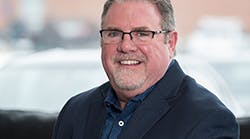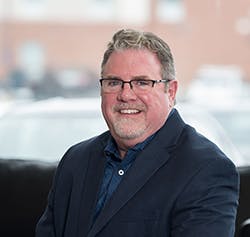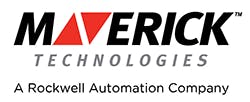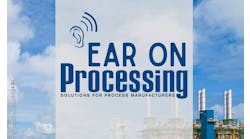Solutions spotlight: The future of manufacturing & continued importance of automation
Control magazine editor in chief Keith Larson and Maverick Technologies’ founder Paul Galeski discuss the future of automation in light of the coronavirus pandemic and the importance of automation personnel going forward.
To learn more, read this interactive whitepaper: http://mavtechglobal.com/fit
Transcript
Keith: Hello, this is Keith Larson, editor of Control Magazine and controlglobal.com. Welcome to this Solution Spotlight edition of our Control Amplified podcast. Today, we're half a year into the global COVID-19 pandemic, and joining me today to tackle nothing less than the future of manufacturing and the continued importance of the automation professional is Paul Galeski, founder of Maverick Technologies, a leading provider of automation services and strategic manufacturing solutions. Welcome, Paul. A real pleasure to talk with you today.
Paul: Hey, good morning, Keith. It's always great to catch up.
Keith: Well, great. Why don't we just jump right in? We've got a lot of interesting subject matter to cover. In some of your recent writings, you've noted how we as an industry, especially those who specialize in automation, we were really, shall I say, caught with our pants down by this whole COVID-19 pandemic. In what ways do you think we didn't have our act together but thought we did? And how did we get it so wrong?
Paul: Yeah, it's pretty crazy. Talk about a paradigm shift. I won't say we got it wrong, Keith, we just didn't get it right. We had looked at the world through the lens that we've all lived in through the past 40/50 years of manufacturing automation, and looked and tried to solve those problems. It's kind of like the army is always built to fight the last war. And COVID has told us all personally, and professionally, that we got a whole new war here. We got a new enemy that we need to attack and manage in a very different way. And it's a more all-encompassing way.
That's how we came up with the notion of FIT, this flexible, intuitive technology, that's it's just more than automation. That's kind of where we fell short. I think we've done a good job of solving the problem and the challenge as we understood it, and as it has presented itself for a long time, and we've evolved and largely done a great job of that. The efficiency of global manufacturing, American manufacturing, it has never been better up until COVID came.
And then COVID comes, and you really have to shine a whole new light on the manufacturing experience. Like in the process industry, for example, you're always focused on what was inside the process. We control the heck out of that. Now, we've got to look at the environment that the process is developed in, and is that environment safe for the employees, and in terms of air quality and things of that nature, which we would have never considered before.
We looked at safety as triple-modular redundant systems and all those things, and have done a great job of those. The world has never been safer from a manufacturing standpoint. But now, we've got a whole new set of challenges to address. So, that's kind of where the evolution is. It's a wakeup call, and we're smart about it, and we'll be a lot better as a result of it.
Keith: Yeah. It seems like we kind of woke up and found out that all these islands of automation that we thought we had fixed were still there, right?
Paul: Yeah, they're still there, and we've tried building some bridges between these islands. To some degree, we've been successful, but sometimes we build a one-lane bridge, and it needs to be a nine-lane bridge or vice versa. The one thing that I posited, and a question I posed when Carol and I talked through this FIT concept is, what would happen if everybody called in sick? And that isn't something we really considered before. We just thought about, how are we going to manage the workforce? How are we going to control the amount of labor hours that we spend? We tried to reduce the amount of labor and all those things, which we've done a good job at, but we never considered it coming at us from the other direction that we didn't have a labor pool. That is gone. In that light, we started seeing the gaps in our automation, and the gaps in the enterprise integration.
Keith: Yeah. It's interesting how employees that were unskilled labor here six months ago are all of a sudden part of essential workers now because I mean, you really can't run the plant without them.
Paul: Yeah, and it's an overdue wake-up call for sure. It's a shame that it took a global pandemic crisis for us to realize that but we're there now, and I think we'll have a better environment for those people to work in both from a physical environment and emotional, but they really do matter at the end of the day. I don't care how good technology gets, we still need people.
Keith: Can you tell me more about kind of the shift in perspective regarding the collaboration of people and machines? I mean, how would you characterize how that perspective needs to change?
Paul: Well, first of all, we've got to do a better job of defining their roles. If you look at a manufacturing environment, as an organization would, so you're developing your org chart, and everybody's got their role and responsibility and job description, I don't know that we've done a good job of defining technology's role, versus labor's role, versus management's role, versus all the outside influences with the extranet and all those things. They all play a role in manufacturing. Before we can go out and become FIT, we have got to develop that whole mosaic of, well, what is everything in its place and its purpose and defining those purposes? Once we define those purposes, then we, as an industry, can solve the problems. But until we define the purposes, we aren't going to solve the interaction.
Keith: Can you tell me a little bit more about the FIT paradigm? You talk about agility and flexibility. It seems like it's been a priority for industry for many years along with solving those islands of automation. What really makes FIT different than the old paradigm of being more flexible and agile?
Paul: Okay, so let's say, let's be flexible. Well, what does that mean? I'll cite something I'll never forget. I'm counseling a person 10-15 years ago, I said, "Hey, man, you just got to be more flexible. In the workplace, you're not flexible, you're too structured." And his answer was, "Give me a specific example of being flexible." Goddamnit, I took my hat off, I threw it on the ground. And that's exactly what I'm talking about.
As we have defined this agility, what is agility? Okay, being quick on your feet, all those kinds of things. In my experience, our view of agility has been one direction. So we get agile and we go forward. Well as we get agile and move forward in an agile way, we need that feedback loop to say, "Okay, we were agile, but we weren't quite agile enough. So, what made us not agile?" That's where the intuitive piece comes in. Not operating in this open-loop environment of agility, or flexibility, or whatever you want to call it but having it learn as we go and get better with use.
The way I look at the world, there's two kinds of businesses, those that get better with use like Google, and those that don't. We really haven't fully explored, and certainly haven't implemented the full complement of AI and all these other tools that are very common in other industries and environments right now. Well, we've got a huge opportunity for growth. Those kinds of things to me is what makes FIT different.
Keith: Yeah. Not to ape your former mentee, but can you give some specific examples of how that might work in terms of a real-time example of adapting to changing conditions where your environment learns?
Paul: Yeah, so let's take somewhat of a concrete example. We've got a set of pumps, and these pumps, they've started misbehaving. They're getting some surges going on, and you've got a heavier amperage load on one than the other, and they go back and forth. And so they're kind of getting sick and something's going on here. As we watch that, we see an outcome that a pump fails or there's a valve failure. Eventually, we wake up and see what the problem is.
Okay, so we fix that. That's open loop, and we keep charging forward again until something else goes wrong. Well, here the software needs to learn what happened, and start seeing that coming, and making adaptations to the process or bringing the human factor in and saying, "Hey, Mr. Operator or Miss Operator, you need to go address this because we think there's problems coming," and then take that resolution. As we're looking forward, it wasn't a concrete resolution necessarily, in that, depending on what our action was, that needs the feedback again. As we continually take samples and have positive feedback, and then adapt that process, it will eventually get to the point where it can come up with many, many solutions to a particular problem or a perceived problem.
Keith: So, leveraging more machine learning, AI type technologies to do base-level, more closed-loop adaptations that are above and beyond what we would normally do just with a PID loop or even an advanced control?
Paul: Yeah, exactly. To provide more contextual information to the human factors that are involved in this organization that we talked about. So, the technology has its role to bring those things bubbling up to the person's attention, and I'm not talking about an alarm that says, "Okay, the valve is closing. It's supposed to be open." That's easy, but, that's obviously closed-loop and old news. But what were the factors that led up to that? And giving that story, the backstory, to the operator, or to the maintenance technician to help them see what happened, and potentially feed back a better resolution before the failure, and before the process interruption, or safety breach or whatever happened.
Keith: Are there particular new types of platforms, or new things that we need to be looking at beyond the traditional DCS, PLC type of arrangement?
Paul: Well, the DCS and the PLC, again, have their role in the organization of manufacturing but that's a defined role, and they do things very well. They turn things on and off, they do regulatory control, and those kinds of things very well. But on top of that, and there's a lot of companies doing it, but we're not far enough along yet, of using software tools on top of that for advanced analytics and those sorts of things to utilize that database that we have back to the islands of automation.
We've got all these islands of data out there that we need to grab that data, turn it into information in real-time, contextual knowledge to the world and more IT tools. Just look at your interaction with Google every day or your interaction with Amazon. What are the things that you can learn about that interaction? If I go into Amazon, and I'm looking for a lawnmower, they tell me I need safety glasses. If you're a maintenance person, and you go out and you're looking in the system, and you're looking at certain things, why couldn't that system prompt you, have you thought about the power quality? Have you thought about the ambient temperature? And those kinds of things to help prompt that human thinking because the humans, at least today, for sure, still connect things better than machines do, and that hopefully is always true, or you don't have a life anymore.
But at any rate, in a situation where we're really making and helping that person think better, and I make the argument, and that's why going to a central workforce is even more important, that that person is going to be used for a higher level task, which requires a different skill set. That skill set to me, and executing that task, would be a lot more rewarding professionally and personally, for that person.
Keith: Yeah, that makes sense. There's been a parallel discussion around this whole kind of path to industrial autonomy, from industrial automation and industrial autonomy, with similar elevation of the role of humans. How is FIT different from that? Or is it some of those same themes with a little bit different focus? Or what's your take on that?
Paul: I can't say that I'm up on what industrial autonomy is or manufacturing autonomy. I'll have to check that out. So, I can't really compare FIT to that. But when I hear autonomy, that word means this thing is off on its own, and it's doing its own thing. And I'm really about bringing manufacturing systems and people and environments more connected to the supply chain, the demand chain and those kinds of things. So, I think that's more what FIT is.
Keith: Yeah, that makes sense. The autonomy is, in my sense, or my understanding of it is to allow potentially greater remote collaboration of people similar to what you were talking about, remote access in some cases, but allow some of the more...
Paul: Okay, so in that light, Keith, then I would say that industrial autonomy is a necessary function of, that is a subset.
Keith: Yeah, yeah. It seems very of a feather as they say.
Paul: Yeah.
Keith: So, what next? I mean, we're six months into this pandemic, and some ways to go apparently. What do manufacturers and processes really need to start doing now, in order to obviously make their way forward through this, but also to be prepared for the next unanticipated thing, whatever that is, coming out the other side of this?
Paul: Well, let's start with what not to do.
Keith: Okay.
Paul: The first thing of what not to do is go in and make a bunch of changes because you think you know what you need to do. Certainly, if there's necessary safety issues that we've learned, you go make those. But before you make a major initiative to take your systems and your process, and your enterprise forward, let's take a step back, and let's recast everything in this new COVID pandemic light. How does that change the landscape? How does it change our priorities? Do a risk-reward analysis, do a SWOT analysis in a new light, and see what you come up with.
Much of what we've done, over the past years and decades, will still be part and parcel of that. But there's this whole new, I hate to use the word category because it's limiting, but there's this whole new group of things that we need to be thinking about, that we haven't been, that we've learned here that were gaps and things that we just didn't see before.
Keith: Or at least didn't prioritize, right?
Paul: Or certainly didn't prioritize. I'm sure there's somebody somewhere, a lot of people said, "Oh, global pandemic." When you analyze these things, you look at the impact versus the probability. So, they say, "Impact, yeah, that's high. Probability is so low. And heck that's not going to happen. This Asian flu thing, bird flu that came out, look at that, much ado about nothing. Just write that off." But now, oh, man, its impact is a five out of five, and its probability is a five out of five because it's happened. So, as you jump that up, that's a real good point you made there.
Keith: It's moved up into a whole new quadrant. Yeah.
Paul: Yeah, exactly.
Keith: Yeah. Absolutely. So, anything else other than taking a good hard look at what their current operations and priorities are? Anything more tangible in terms of moving forward?
Paul: Yeah. Looking at your people, and making sure you've got the right people in the organization that can drive this new paradigm. Have an open mind, and really don't accept business as usual that reject the status quo that says, "Hey, folks, how we've been doing this, this just ain't going to work anymore." And when I say, how are we doing this? How are we going about strategic planning? How are we developing our strategic roadmap? What are just the big picture items just to the what we need to do? How do we take a new look at that?
Because once we develop a what, we're usually pretty good at getting the how. But if we get what we need to do, if we don't get that right and don't think about it in a big, free-thinking way, then the how is going to miss the target like it has before.
Keith: All right. Well, I think everybody who's listening has their homework assignments now. So, if you're a little bit less busy during this downturn, you've just got your assignment to go forward and take a clean sheet of paper. Is that fair to say?
Paul: Absolutely, and I just would say take an open mind, but maybe paper is not even part of it anymore.
Keith: Well, that's true. That's true, very archaic technologies. Although as a magazine publisher, I like to say there's still some place for paper. But hopefully, for a little bit anyway.
So, I really wanted to thank you. Thank you, Paul, for sharing your insights with us today. And for those of you who are listening, really thanks for tuning in. I'm Keith Larson. You've been listening to a Control Amplified podcast. Thank you Paul Galeski, Maverick Technologies for joining us. Thanks, Paul. And if you've enjoyed this episode, you can subscribe at the iTunes Store and at Google Podcasts. Plus, you can find the full archive of past episodes at controlglobal.com. Signing off. Until next time, stay safe and stay sound. Thanks again.
For more, tune into Control Amplified: The Process Automation Podcast





